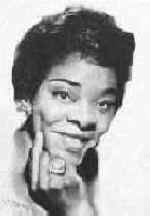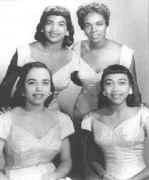 Little Esther/Robins |
 Savannah Churchill/Four Tunes |
|
 Dinah Washington/Ravens Voted into the Rock Hall |
 Viola Watkins/Crows |
Distaff-doo-wop refers to to the contributions of females to the body of doo-wop works. Earlier contributions were made by Shirley Gunter and the Queens, the Bobbettes, Tonnettes, Chantels and Shirelles. On occasions woman lead singers fronted male groups, Zola Taylor with the Platters, Pat Spann the Cleftones and Barbara Lee with the Aquatones. With these few exceptions, women did not play a prominent role in doo wop until the 1962-1963 neo-doo wop Tin Pan Alley sound grew in favor.
Prominent Examples |
| Group | Song | Tempo | Year |
| Blue Belles Bobbettes Chantels Cookies Delrons Poni-tails Shirley Gunter and the Queens Rosebuds Shirelles Tonettes |
You'll
Never Walk Alone Mr. Lee Maybe Don't Say Nothin' Bad Whever A Teenager Cries Born Too Late Oop-Shoop Dearest Darling Will You Still Love Me Tomorrow Oh What A Baby |
slow fast slow fast medium slow fast slow slow fast |
1963 1957 1958 1963 1964 1958 1954 1957 1960 1958 |
|
 Little Esther/Robins |
 Savannah Churchill/Four Tunes |
|
 Dinah Washington/Ravens Voted into the Rock Hall |
 Viola Watkins/Crows |
From July, 1948 when Savannah Churchill backed by the Four Tunes charted with I Want To Cry until October, 1954 Shirley Gunter and the Queens charted Oop-Shoop, only three records by women appeared on the R&B chart. Those two were by Ella Fitzgerald and other by Little Esther with the Robins (Double Crossn' Blues) February, 1950.
Little Esther also did Other Lips, Other Arms and Heart To Heart (1951) with Clyde McPhatter, Savannah Churchill recorded Let's Call A Spade A Spade (1947, Five Kings), Can Anyone Explain (1950, Four Tunes) and Once There Lived A Fool (1950, Striders). Ruth Brown with the Delta Rhythm Boys did Sentimental Journey and It's All In Your Mind and Ann Nichols with The Bluebirds.
1954-1957 |
 Bobbettes |
 Cookies |
 Chantels |
 Deltairs |
 Dreamers/Blossoms |
 Hearts |
 Joytones |
 Queens |
 Etta James and Peaches |
 Three Tons of Joy |
The groups chosen above were based on they having made Billboards R&B chart
1958-1964 |
The problem with distaff groups were that their songs weren't to doo woppy to begin with. The voices didn't different much because of a lack of a contrasting lower voices as was common among the male groups.The Hearts on Baton being an exception. Sometimes a male was added to sing a bassline (What A Guy by the Raindrops) or by having the female lead backed by a male group (Hello Stranger - Barbara Lewis and with the Dells). Most lacked nonsense syllables with the Shirelles I Met Him On A Sunday and Chiffonss He's So Fine being notable exceptions.
Lacking a bass, thus having a restricted voice range and the lack of nonsense syllables can these songs be called doo wop. Certainly they didn't resemble the McGuirre Sisters and the Chordettes. Many like the Cookies and Chiffons fell within the boundaries of doo wop and rhythm and blues.
The groups chosen above were based on their having made Billboard's R&B chart